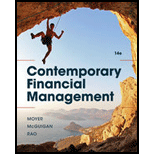
Contemporary Financial Management, Loose-leaf Version
14th Edition
ISBN: 9781337090636
Author: R. Charles Moyer, James R. McGuigan, Ramesh P. Rao
Publisher: South-Western College Pub
expand_more
expand_more
format_list_bulleted
Concept explainers
Question
Chapter 16, Problem 4QTD
Summary Introduction
To discuss: The difference among fluctuating current assets and permanent current assets.
Expert Solution & Answer
Trending nowThis is a popular solution!

Students have asked these similar questions
Ans
A company has a beta of 1.2, the risk-free rate is 3%, and the expected market return is 8%. Using the Capital Asset Pricing Model (CAPM), calculate the expected return on the company's stock. Need help !!!
A company has a beta of 1.2, the risk-free rate is 3%, and the expected market return is 8%. Using the Capital Asset Pricing Model (CAPM), calculate the expected return on the company's stock.
A firm issues a preferred stock with a dividend of $6 per year. If the market price of the preferred stock is $80, what is the cost of preferred equity for the firm?
Chapter 16 Solutions
Contemporary Financial Management, Loose-leaf Version
Ch. 16 - Prob. 1QTDCh. 16 - Prob. 2QTDCh. 16 - Prob. 3QTDCh. 16 - Prob. 4QTDCh. 16 - Prob. 5QTDCh. 16 - Prob. 6QTDCh. 16 - Prob. 7QTDCh. 16 - Prob. 8QTDCh. 16 - Prob. 9QTDCh. 16 - Prob. 10QTD
Ch. 16 - Prob. 11QTDCh. 16 - Prob. 12QTDCh. 16 - Prob. 13QTDCh. 16 - Prob. 14QTDCh. 16 - Prob. 15QTDCh. 16 - Prob. 16QTDCh. 16 - Prob. 17QTDCh. 16 - Prob. 18QTDCh. 16 - Prob. 19QTDCh. 16 - Prob. 20QTDCh. 16 - Prob. 21QTDCh. 16 - Prob. 22QTDCh. 16 - Prob. 23QTDCh. 16 - Prob. 24QTDCh. 16 - Prob. 1PCh. 16 - Prob. 2PCh. 16 - Prob. 3PCh. 16 - Prob. 4PCh. 16 - Prob. 5PCh. 16 - Prob. 6PCh. 16 - Prob. 7PCh. 16 - Prob. 8PCh. 16 - Prob. 9PCh. 16 - Prob. 10PCh. 16 - Prob. 11PCh. 16 - Prob. 12PCh. 16 - Prob. 13PCh. 16 - Prob. 14PCh. 16 - Prob. 15PCh. 16 - Prob. 16PCh. 16 - Prob. 17PCh. 16 - Prob. 18PCh. 16 - Prob. 19PCh. 16 - Prob. 20PCh. 16 - Prob. 21PCh. 16 - Prob. 22PCh. 16 - Prob. 23PCh. 16 - Prob. 24PCh. 16 - Prob. 25PCh. 16 - Prob. 26PCh. 16 - Prob. 27PCh. 16 - Prob. 28PCh. 16 - Prob. 29PCh. 16 - Prob. 30PCh. 16 - Prob. 31PCh. 16 - Prob. 32PCh. 16 - Prob. 33PCh. 16 - Prob. 34P
Knowledge Booster
Learn more about
Need a deep-dive on the concept behind this application? Look no further. Learn more about this topic, finance and related others by exploring similar questions and additional content below.Similar questions
- Give answer.Explain the difference between a primary market and a secondary market. Why are both important in financial markets?arrow_forwardExplain the difference between a primary market and a secondary market. Why are both important in financial markets? Need help!!arrow_forwardQuestion: A company has issued a bond with a face value of $1,000, a coupon rate of 5%, and a maturity of 10 years. If the bond is currently trading at $950, what is the bondholder's yield to maturity (YTM), and how does it differ from the coupon rate? need help!!arrow_forward
- A company has issued a bond with a face value of $1,000, a coupon rate of 5%, and a maturity of 10 years. If the bond is currently trading at $950, what is the bondholder's yield to maturity (YTM), and how does it differ from the coupon rate?arrow_forwardWhat is the time value of money, and why is it important in financial decision-making? Need help!arrow_forwardWhat is the time value of money, and why is it important in financial decision-making?arrow_forward
- Please don't use chatgpt. The formula for calculating the present value of a future amount is:A) Future Value × (1 + r)^nB) Future Value ÷ (1 + r)^nC) Future Value × (1 - r)^nD) Future Value ÷ (1 - r)^n help in this question.arrow_forwardThe formula for calculating the present value of a future amount is:A) Future Value × (1 + r)^nB) Future Value ÷ (1 + r)^nC) Future Value × (1 - r)^nD) Future Value ÷ (1 - r)^n need help!arrow_forwardno ai What is the primary purpose of diversification in investing?A) To maximize returnsB) To eliminate all riskC) To reduce unsystematic riskD) To ensure stable dividendsarrow_forward
- no chatgpt Which of the following is a capital structure decision?A) Deciding how much to pay in dividendsB) Deciding how to allocate funds to various projectsC) Deciding the mix of debt and equity financingD) Deciding how much inventory to purchase need help!arrow_forwardWhich of the following is a capital structure decision?A) Deciding how much to pay in dividendsB) Deciding how to allocate funds to various projectsC) Deciding the mix of debt and equity financingD) Deciding how much inventory to purchasearrow_forwardNo chatgpt!! The weighted average cost of capital (WACC) is used to:A) Measure the profitability of a companyB) Determine the cost of debt financing onlyC) Calculate the company’s average cost of financing from debt and equityD) Estimate the future stock price need help.arrow_forward
arrow_back_ios
SEE MORE QUESTIONS
arrow_forward_ios
Recommended textbooks for you
 EBK CONTEMPORARY FINANCIAL MANAGEMENTFinanceISBN:9781337514835Author:MOYERPublisher:CENGAGE LEARNING - CONSIGNMENTPrinciples of Accounting Volume 1AccountingISBN:9781947172685Author:OpenStaxPublisher:OpenStax College
EBK CONTEMPORARY FINANCIAL MANAGEMENTFinanceISBN:9781337514835Author:MOYERPublisher:CENGAGE LEARNING - CONSIGNMENTPrinciples of Accounting Volume 1AccountingISBN:9781947172685Author:OpenStaxPublisher:OpenStax College

EBK CONTEMPORARY FINANCIAL MANAGEMENT
Finance
ISBN:9781337514835
Author:MOYER
Publisher:CENGAGE LEARNING - CONSIGNMENT

Principles of Accounting Volume 1
Accounting
ISBN:9781947172685
Author:OpenStax
Publisher:OpenStax College
Liquidity Risk (FRM Part 2 – Book 4 – Chapter 1); Author: AnalystPrep;https://www.youtube.com/watch?v=TguAvyxM6vg;License: Standard Youtube License